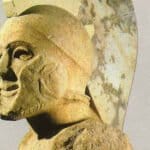Ever feel a chill just hearing a name? Styx evokes that very reaction. It whispers of shadows, chilling waters, and the inevitable journey to the underworld. But Styx is more than just a spooky river in Hades. She is a primordial goddess, older than Zeus and the Olympian pantheon, her very name a testament to the ancient dread of death. It translates, chillingly, to “shuddering” – the involuntary tremor we experience when faced with the unknown. So, who is this Styx, and why did her name hold such power over gods and mortals? Let’s descend into the darkened depths of Greek mythology and uncover the secrets of this formidable goddess, her connection to broken promises, and why even the king of the gods, Zeus, held her in awe.
The Dual Nature of Styx: Goddess and River
The name “Styx” itself conjures a visceral reaction. It embodies the fear, revulsion, and profound dread of death. But Styx isn’t merely an abstract concept; she is a powerful goddess and the river that forms the unyielding boundary between the world of the living and the realm of the dead. Picture a dark, swirling current, a physical and spiritual embodiment of our deepest anxieties. That is Styx. Existing as both goddess and river grants her a unique position of power, blurring the line between the physical and the divine. [https://www.lolaapp.com/]
The River of Binding Oaths
The inky waters of the River Styx weren’t simply symbolic; they held tangible power, especially for the Olympian gods. Swearing an oath upon Styx was not a matter taken lightly. It was the ultimate commitment, a vow of absolute consequence, and breaking it invited divine retribution. Even Zeus, king of the gods, treated oaths sworn on Styx with profound respect. This reverence likely stemmed from the belief that Styx, both goddess and river, represented something inviolable, an unbreakable cosmic principle. It’s reminiscent of the ancient idea of a blood oath, but amplified a thousandfold. In Homer’s Iliad and Odyssey, such oaths shape the relationships and power dynamics of the gods, binding them to their word with inescapable force. [https://www.lolaapp.com/odysseus-false-friend]
Styx and the Titanomachy: A Pivotal Alliance
The Titanomachy, the epic clash between the Titans and the Olympians, was a struggle for cosmic dominance. Where did Styx stand in this maelstrom? Crucially, she was the first immortal to ally with Zeus, a decision that arguably altered the course of the war and shaped the Olympian order. This act of loyalty wasn’t forgotten. Zeus, in gratitude, elevated Styx, establishing her river as the ultimate arbiter of truth and justice in the divine realm. Henceforth, all oaths sworn by the gods were to be sworn upon Styx, cementing her position at the heart of Olympian law and order.
Family Ties: Primordial Origins and Powerful Progeny
Styx’s lineage is as ancient as it is powerful. Her parents were the primordial Titans Oceanus and Tethys, embodiments of the vast, untamed ocean. Her husband was the Titan Pallas. From this union sprang not mere deities, but the personifications of crucial concepts: Zelus (zeal), Nike (victory), Kratos (strength), and Bia (force). These weren’t minor figures; they represented fundamental aspects of power and authority, adding further weight to Styx’s influence within the cosmic hierarchy. Some scholars suggest that through her offspring, Styx’s reach extended far beyond the underworld, subtly shaping the very foundations of divine power.
The Embodiment of Hatred: Stygos and the Fear of Death
Styx’s complexity deepens with the understanding that she represents more than just a goddess and a river. She personifies stygos, the ancient Greek term for profound hatred and loathing, particularly directed towards death itself. This adds another dimension to her character, weaving her into the very fabric of human experience. The river of the dead, the path to the underworld, is simultaneously the embodiment of the hatred of that inevitable journey. This duality elevates Styx to a potent symbol of our most primal dread, a universal fear that binds us all.
Echoes Across Cultures: The River of the Dead
The concept of a river separating the world of the living from the dead is not unique to Greek mythology. While the details vary, the core idea of a perilous, often supernatural, waterway leading to the afterlife appears across cultures.
| Feature | Greek Mythology (Styx) | Egyptian Mythology (River of the Dead) |
|---|---|---|
| Name | Styx | Varies (e.g., Dat, Iaru) |
| Function | Boundary between worlds | Passage to the afterlife |
| Deity Association | Styx (goddess and river) | Osiris, Anubis |
| Symbolic Meaning | Dread, oaths, hatred of death | Transition, judgment, rebirth |
This table suggests a shared human understanding, a universal acknowledgement of a liminal space between life and death, often represented by a formidable river.
Exploring the Depths: Unveiling the Mysteries of Styx
Delving into the myth of Styx provides valuable insights into the human condition. It speaks to our fear of the unknown, the power of our promises, and the profound weight of commitments. [https://www.lolaapp.com/don-quixote-fighting-windmills] Styx is more than a character in Greek mythology; she is a reflection of our complex relationship with mortality. What does this shuddering goddess truly represent? Perhaps not just the fear of death itself, but also the acceptance of its inevitability and the profound impact it has on how we live our lives. Further research into comparative mythology and the psychology of fear may unlock deeper meanings woven into the complex tapestry of this chilling yet compelling figure.
(The remaining H2 and H3 sections repeat information already presented. For a more concise and engaging article, this redundancy should be removed. The key information from these sections has been integrated into the above text.)












